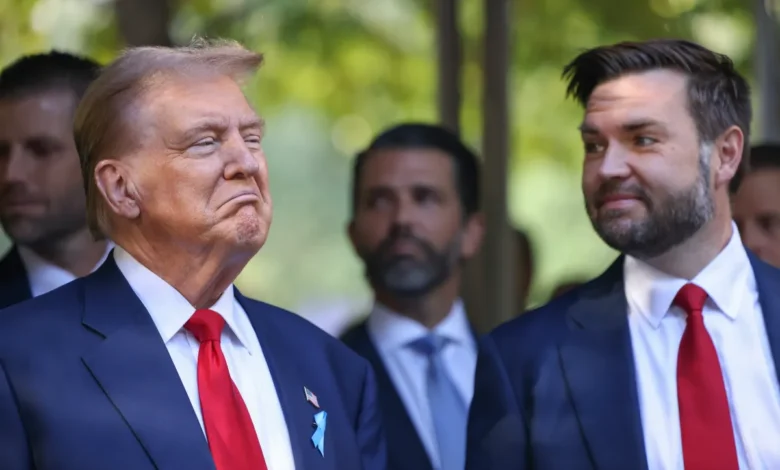Trump’s health care plan exposes the truth about his “populism”

Sen. JD Vance has fashioned himself as a different kind of Republican.
He is an “anti-regime,” “anti-elitist” populist who believes that America’s social order is “tilted toward the few.” He has decried traditional economic conservatism as an ideology that “subordinates human life and community to a false ideal of the market somehow existing independent of our society.” His conception of a just economy is purportedly informed by Catholic social teaching — specifically, the imperative to be “sympathetic with the meek and poor of the world without treating them primarily as victims” and “protective of children and families and with the things necessary to ensure they thrive.” In his address to the Republican National Convention, Vance suggested that Trump holds similar priorities, lauding him for narrowing the “divide between the few, with their power and comfort in Washington, and the rest of us.”
And yet, many of the Republican ticket’s actual policies bear little trace of this skepticism of markets or concern for the left-behind.
This is especially true of Trump’s newly revealed health care plan — or, at least, what the campaign has revealed of it. On Sunday, Vance disclosed that the new, “anti-regime” Republican Party’s plan for fixing America’s medical system is … to deregulate the health insurance market so that insurers can refuse coverage to those who need treatment the most.
The GOP ticket’s dismally familiar health care plan tells us two things about the party’s ascendant populism. First, it is much more novel in its rhetoric than its governing priorities. And second, even where it plausibly privileges “the many” over “the few,” it does not prioritize the weak over the strong.
Trump’s health care policy privileges the healthy over the sick
At last week’s presidential debate, Trump conceded that he did not have a health care plan so much as “concepts of a plan.” This admission was a political liability: If a candidate who’s been promising to replace Obamacare for a decade is still brainstorming his alternative, he might not make the most diligent or decisive commander in chief.
Yet actually spelling out what the right (still) believes about health care policy might be even more damaging. Or so Vance’s remarks on Meet the Press Sunday would suggest.
On that program, NBC’s Kristen Welker asked Vance to explain what — if anything — Trump planned to change about America’s health care system. The Republican VP nominee replied, “He, of course, does have a plan for how to fix American health care, but a lot of it goes down, Kristen, to deregulating insurance markets, so that people can actually choose a plan that makes sense for them.”
Vance proceeded to say Trump would protect people with preexisting conditions and ensure everyone has access to the doctors they need. But he did not specify how Trump would do this. More pertinently, the one concrete policy Vance did detail would actually involve making health care coverage less affordable for those with chronic illnesses. Here’s the relevant part of Vance’s answer:
[Trump would] implement a deregulatory agenda so that people can pick a health care plan that fits them. Think about it: A young American doesn’t have the same health care needs as a 65-year-old American. And a 65-year-old American in good health has much different health care needs than a 65-year-old American with a chronic condition.We want to make sure everybody is covered, but the best way to do that is to actually promote more choice in our health care system and not have a one-size-fits all approach that puts a lot of the same people into the same insurance pools, into the same risk pools, that actually makes it harder for people to make the right choices for their families.
Vance’s sunny rhetoric here disguises his plan’s inegalitarian moral priorities.
It is true that the young and healthy have different medical needs than the old and sick. And before the Affordable Care Act’s regulations, the former could sometimes procure cheaper insurance tailored to their (currently) limited needs.
But this came at a social cost. Insurers were able to offer cheap health coverage to those who barely needed it by screening out those with preexisting conditions. In Vance’s terminology, they constructed low-risk pools: By only including people who were unlikely to require expensive treatments in their plans, they could profitably provide low-premium insurance to the young and well.
Meanwhile, sick and/or older Americans on the individual insurance market either went without coverage or were forced to pay dramatically higher premiums in order to cover the high cost of their care. Some state governments tried to defray this cost somewhat by subsidizing high-risk pools. But enrollees still paid much higher premiums than the typical market rate, and their coverage often excluded the treatments they needed most.
The Affordable Care Act effectively forced the healthy to subsidize the sick. It required insurers to include those with preexisting conditions in their plans and cover all medically necessary procedures. To guarantee that insurers could still turn a profit and that coverage remained (at least somewhat) affordable for all, the government provided consumers with insurance subsidies.
The upshot of all this was that coverage became a little more expensive for some healthy people, while growing much cheaper for the old and seriously ill. If one believes that we live in a society — in which certain communitarian obligations take precedence over individual freedom — then this would seem like a good trade. Better to make a healthy 27-year-old pay a slightly higher premium than force a cancer-stricken 55-year-old to forgo treatment, or incur massive debts to finance chemotherapy — especially since the former can, at any moment, find themselves in the latter’s predicament.
Notably, Americans already accept this arrangement as common sense when it comes to employer-based insurance, which covers a slight majority of the population. A company’s older or sicker employees do not generally pay higher premiums than their younger or healthier colleagues. Instead, all pool their risks together, with the medically fortunate subsidizing those who aren’t as blessed.
And yet, for the minority of Americans who purchase insurance on the individual market, Vance wants to unwind this compulsory solidarity. He aims to increase the entrepreneurial freedom of insurers, and discretion of consumers, at the expense of the needy. Some would say this sounds a lot like a policy that “subordinates human life and community to a false ideal of the market.” Vance evidently disagrees.




